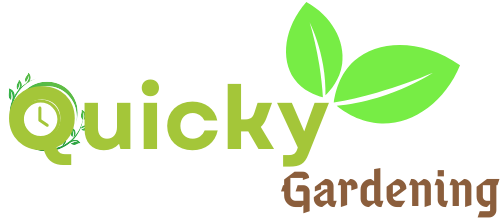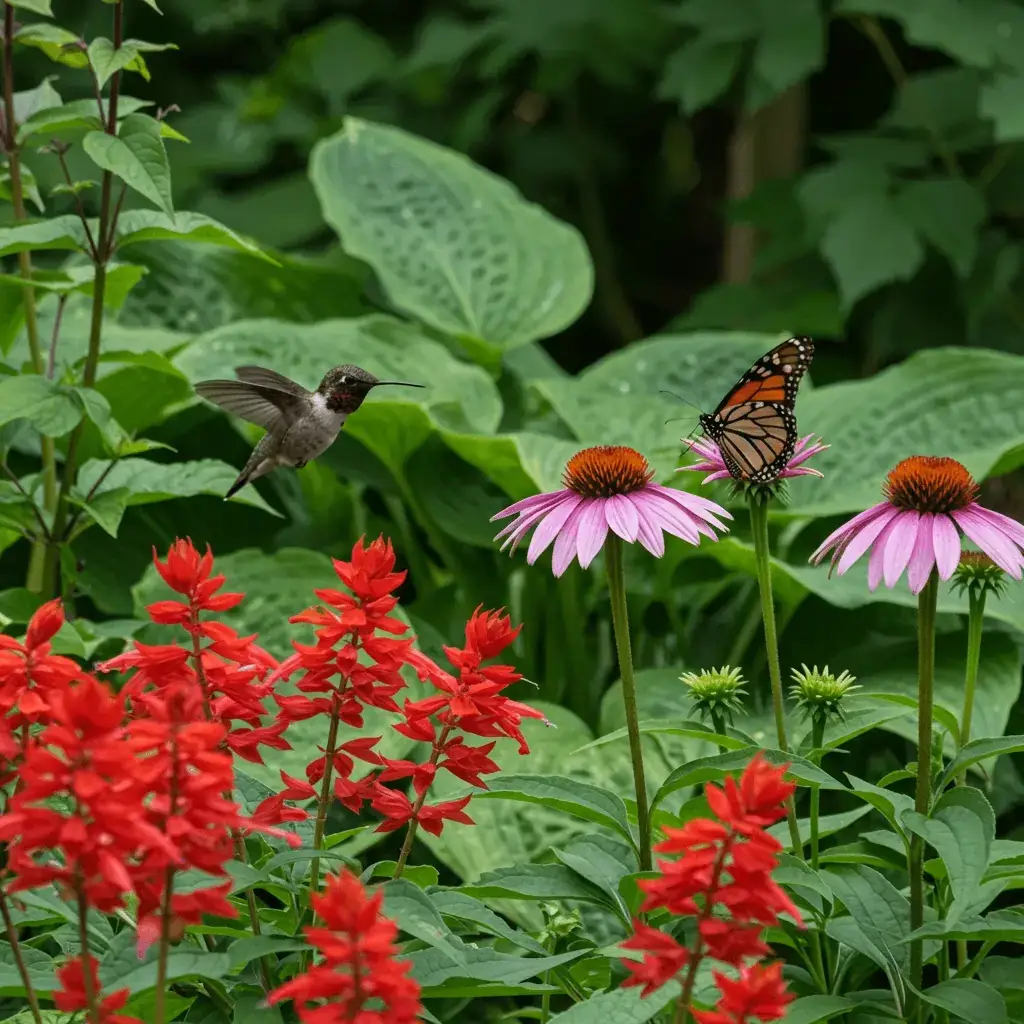If you want to create a vibrant and lively garden, choosing plants that attract hummingbirds and butterflies is essential. These beautiful pollinators not only bring color and movement to your outdoor space but also help plants reproduce by transferring pollen. By selecting the right flowers, shrubs, and vines, you can transform your garden into a haven for hummingbirds and butterflies, providing them with the nectar and shelter they need to thrive.
When selecting plants that attract hummingbirds and butterflies, it’s essential to consider factors such as nectar availability, bloom time, and whether the plant is native to your region. In this guide, we’ll explore the best flowers, shrubs, and gardening techniques to make your outdoor space a paradise for these winged visitors.
1. Understanding the Needs of Hummingbirds and Butterflies
Before choosing plants, it’s crucial to understand what hummingbirds and butterflies look for in a garden. Their needs are quite similar, but there are some key differences to keep in mind.
Importance of Nectar-Rich Plants
Both hummingbirds and butterflies rely on nectar as their primary food source. Plants with bright-colored flowers, particularly red, pink, orange, and yellow, tend to attract hummingbirds. Butterflies, on the other hand, are drawn to a variety of colors, especially purple, blue, and white.
Native vs. Non-Native Plants
Choosing native plants is one of the best ways to attract local hummingbird and butterfly species. Native plants are naturally adapted to your region’s soil and climate, making them easier to maintain. They also provide the right kind of nectar and support the ecosystem by attracting other beneficial insects.
Best Conditions for Attracting Pollinators
- Sunlight: Most nectar-producing plants thrive in full sun, so make sure to plant them in a sunny location.
- Shelter: Hummingbirds and butterflies need a safe place to rest. Trees, shrubs, and vines provide protection from predators and the elements.
- Water Source: A shallow water dish or birdbath helps butterflies and hummingbirds stay hydrated.
Read More:
2. Top Flowering Plants for Hummingbirds and Butterflies
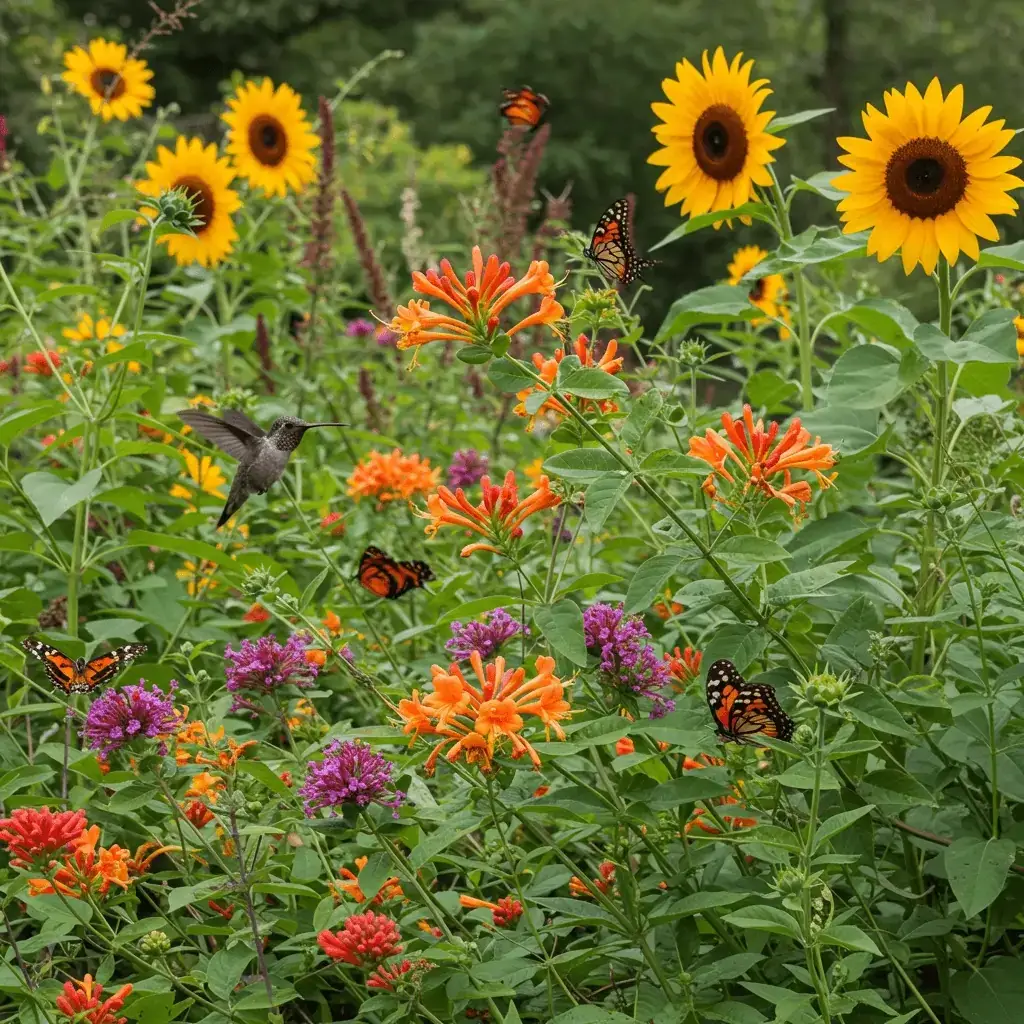
The right combination of flowers can keep hummingbirds and butterflies visiting your garden throughout the growing season. Below are some of the best plant choices.
Perennials That Attract Hummingbirds and Butterflies
Perennials are an excellent choice since they come back year after year, providing a reliable food source for pollinators.
- Bee Balm (Monarda): A favorite of both hummingbirds and butterflies, this plant produces bright red, pink, and purple flowers rich in nectar.
- Coneflowers (Echinacea): These drought-tolerant flowers attract butterflies with their daisy-like blooms and provide seeds for birds in the fall.
- Salvia (Salvia spp.): Known for its tubular flowers, salvia is highly attractive to hummingbirds.
Annuals That Attract Hummingbirds and Butterflies
Annuals grow quickly and produce flowers throughout the season, making them a great addition to a pollinator garden.
- Zinnias (Zinnia spp.): These brightly colored flowers attract butterflies and are easy to grow.
- Lantana (Lantana camara): Lantana produces clusters of tiny flowers that both hummingbirds and butterflies love.
- Petunias (Petunia spp.): A great low-maintenance option that provides long-lasting nectar sources.
Shrubs and Vines for Long-Lasting Blooms
- Butterfly Bush (Buddleia davidii): As the name suggests, this shrub is a butterfly magnet and also attracts hummingbirds.
- Honeysuckle (Lonicera spp.): Produces tubular, fragrant flowers that hummingbirds can’t resist.
- Milkweed (Asclepias spp.): Essential for Monarch butterflies as a host plant for caterpillars.
3. How to Create a Hummingbird and Butterfly-Friendly Garden
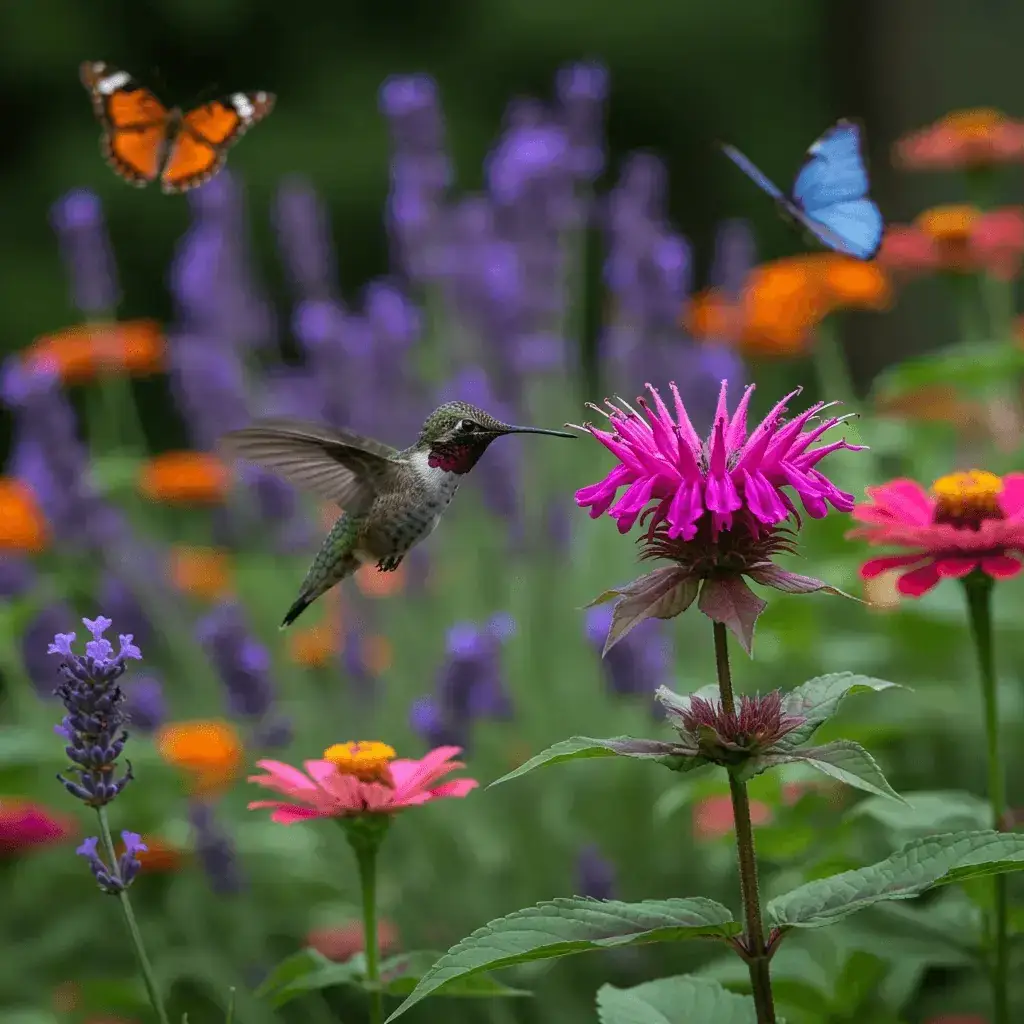
Once you’ve selected your plants, it’s important to create an environment where pollinators will feel safe and welcomed.
Plant in Clusters for Maximum Visibility
Hummingbirds and butterflies are more likely to find nectar sources when flowers are grouped together rather than spaced apart. Plant clusters of the same species to make it easier for them to locate food.
Choose Plants with Staggered Bloom Times
To provide nectar throughout the year, choose a mix of plants that bloom at different times of the season. This ensures that hummingbirds and butterflies always have a food source.
Provide Water Sources
A small birdbath or a shallow dish with stones for perching will attract butterflies and keep hummingbirds hydrated.
Add Rocks and Flat Surfaces for Sunbathing
Butterflies often bask in the sun to regulate their body temperature. Providing flat stones or logs in your garden will give them a place to rest.
4. Common Mistakes to Avoid When Choosing Plants
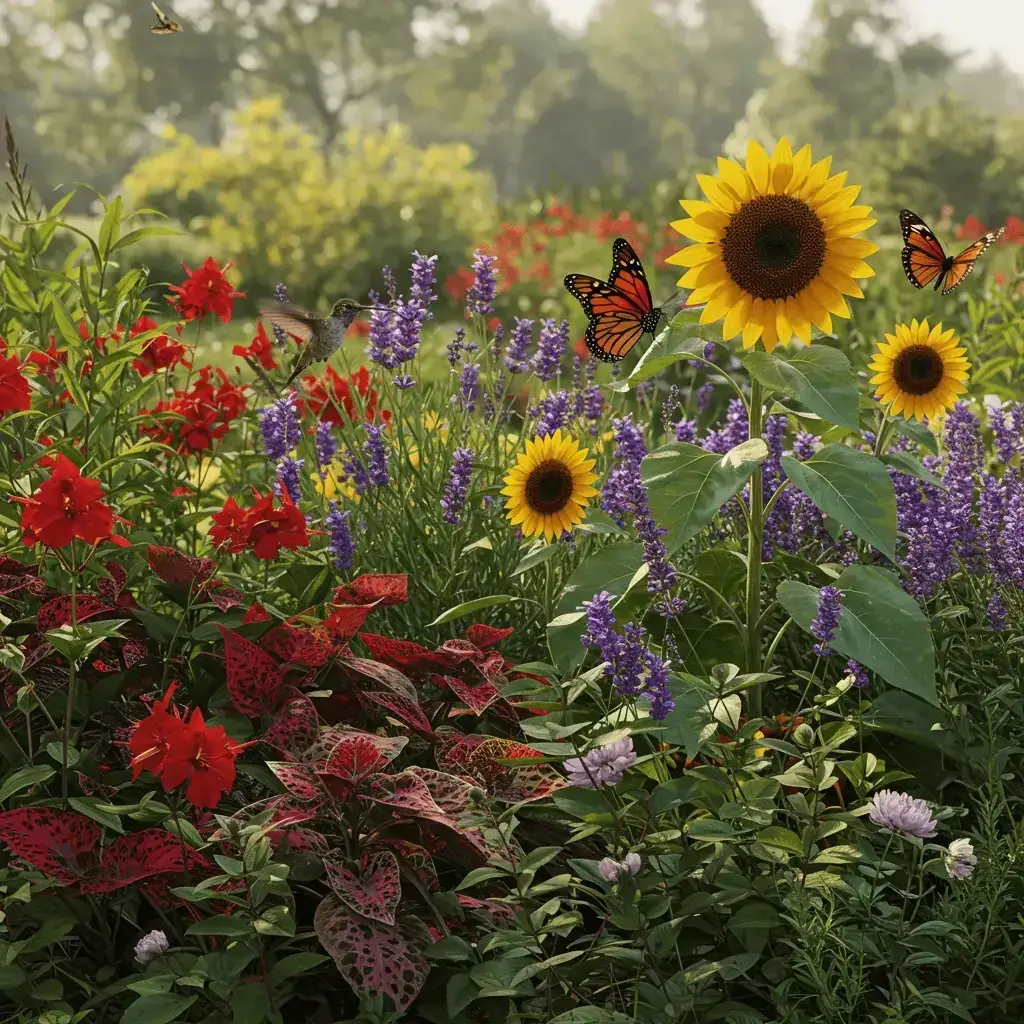
Even with the best intentions, some gardening practices can deter hummingbirds and butterflies from visiting your garden.
Using Pesticides
Pesticides and insecticides can be harmful to pollinators. Instead of chemicals, opt for natural pest control methods like introducing ladybugs or using neem oil.
Choosing Hybrid Plants
Many hybrid plants have been bred for appearance rather than nectar production. Always choose open-pollinated or heirloom varieties for a better nectar supply.
Ignoring USDA Hardiness Zones
Not all plants thrive in every region. Check your USDA hardiness zone before planting to ensure your selections will survive in your climate.
FAQ
1. What are the best plants to attract both hummingbirds and butterflies?
Some of the best plants include Bee Balm, Salvia, Coneflowers, Zinnias, Lantana, and Butterfly Bush.
2. How can I keep hummingbirds and butterflies coming back to my garden?
Provide a consistent source of nectar, plant a variety of flowers with staggered bloom times, and avoid using pesticides.
3. Do hummingbirds and butterflies prefer different types of flowers?
Hummingbirds are attracted to tubular, nectar-rich flowers, while butterflies prefer flat, open flowers where they can land easily.
4. Can I grow these plants in containers?
Yes! Many pollinator-friendly plants, such as Lantana and Zinnias, grow well in containers on patios or balconies.
5. Why are native plants important for pollinators?
Native plants provide the right type of nectar and habitat that local hummingbirds and butterflies need to thrive.
6. What time of year do hummingbirds and butterflies visit gardens?
Hummingbirds and butterflies are most active in spring and summer when nectar-rich flowers are in bloom.
7. How can I protect butterflies and hummingbirds from predators?
Planting dense shrubs and providing cover will give them a safe place to hide from predators like cats and larger birds.
8. Do hummingbirds and butterflies need special food supplements?
Natural nectar from flowers is best, but you can supplement hummingbirds with a sugar-water feeder. Avoid using dyed nectar.
9. How do I keep ants out of my hummingbird feeder?
Use an ant moat above your feeder or apply petroleum jelly to the hanger to deter ants.
10. Can hummingbirds and butterflies coexist in the same garden?
Yes! Many nectar-rich plants attract both species, and they can share the same space without issu
Conclusion
Choosing plants that attract hummingbirds and butterflies is a rewarding way to enhance your garden’s beauty and support local wildlife. By selecting the right plants and avoiding common mistakes, you can create a thriving pollinator-friendly environment.
